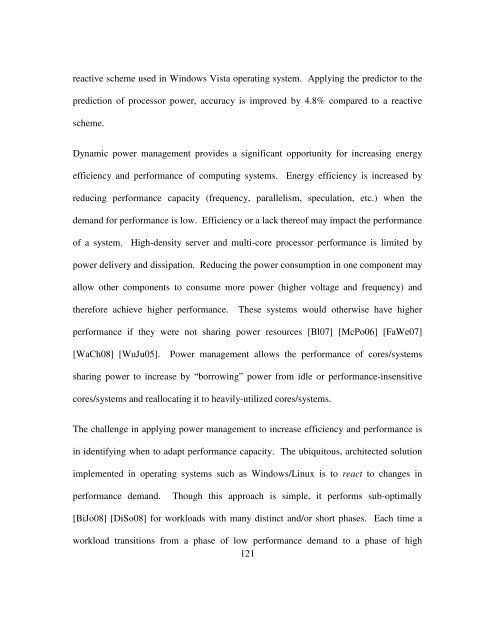Copyright by William Lloyd Bircher 2010 - The Laboratory for ...
Copyright by William Lloyd Bircher 2010 - The Laboratory for ...
Copyright by William Lloyd Bircher 2010 - The Laboratory for ...
You also want an ePaper? Increase the reach of your titles
YUMPU automatically turns print PDFs into web optimized ePapers that Google loves.
eactive scheme used in Windows Vista operating system. Applying the predictor to the<br />
prediction of processor power, accuracy is improved <strong>by</strong> 4.8% compared to a reactive<br />
scheme.<br />
Dynamic power management provides a significant opportunity <strong>for</strong> increasing energy<br />
efficiency and per<strong>for</strong>mance of computing systems. Energy efficiency is increased <strong>by</strong><br />
reducing per<strong>for</strong>mance capacity (frequency, parallelism, speculation, etc.) when the<br />
demand <strong>for</strong> per<strong>for</strong>mance is low. Efficiency or a lack thereof may impact the per<strong>for</strong>mance<br />
of a system. High-density server and multi-core processor per<strong>for</strong>mance is limited <strong>by</strong><br />
power delivery and dissipation. Reducing the power consumption in one component may<br />
allow other components to consume more power (higher voltage and frequency) and<br />
there<strong>for</strong>e achieve higher per<strong>for</strong>mance. <strong>The</strong>se systems would otherwise have higher<br />
per<strong>for</strong>mance if they were not sharing power resources [Bl07] [McPo06] [FaWe07]<br />
[WaCh08] [WuJu05]. Power management allows the per<strong>for</strong>mance of cores/systems<br />
sharing power to increase <strong>by</strong> “borrowing” power from idle or per<strong>for</strong>mance-insensitive<br />
cores/systems and reallocating it to heavily-utilized cores/systems.<br />
<strong>The</strong> challenge in applying power management to increase efficiency and per<strong>for</strong>mance is<br />
in identifying when to adapt per<strong>for</strong>mance capacity. <strong>The</strong> ubiquitous, architected solution<br />
implemented in operating systems such as Windows/Linux is to react to changes in<br />
per<strong>for</strong>mance demand. Though this approach is simple, it per<strong>for</strong>ms sub-optimally<br />
[BiJo08] [DiSo08] <strong>for</strong> workloads with many distinct and/or short phases. Each time a<br />
workload transitions from a phase of low per<strong>for</strong>mance demand to a phase of high<br />
121




